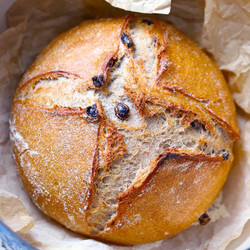Microwave the 1 ½ cups water until it's 100 degrees F - 110 degrees F (this takes one minute on high in my microwave). In a large bowl or the bowl of a standing mixer, mix 1 cup of the warm water with the 2 ¼ teaspoons active dry yeast and 2 tablespoons sugar and stir until everything is dissolved. Allow to stand for 10 minutes, after which the yeast should have started multiplying resulting in the mixture foaming up to about double its size.
Meanwhile, pour the remaining ½ cup of warm water over the ¾ cup raisins in a small bowl and mix together and allow to sit for 10 minutes. This will rehydrate the raisins a bit and make them plumper and softer.
Add the raisin and warm water mixture, the 1 tablespoon cinnamon, the ½ tablespoon fine grain salt, and the 3 ½ cups all-purpose flour to the bowl with the water yeast mixture. Mix using a dough hook on the standing mixer, or with a sturdy wooden spoon if mixing by hand, for at least 1 minute, until all the ingredients are well combined. (If using a standing mixer, mix for a little longer, which will develop more gluten and result in a stronger dough).
Gather the dough at the bottom of the bowl by scraping the sides down. Cover the bowl with plastic wrap or a damp towel and allow to rise in a warm place for about 2 hours, or until the dough has doubled in size. At this point, if you like, you can refrigerate the dough for up to 7 days and bake when you are ready. A cold dough has some benefits, as it is easier to shape and form, and the longer the dough sits the more developed in flavor it will be. Or, you can bake immediately!)
Optional: during the last 30 minutes of the dough rising, preheat your Dutch oven by placing it, covered, in your oven while it preheats to 450 degrees F. This isn't entirely necessary but the extra heat will give the dough a bit of a boost when it comes to how tall and fluffy it comes out.
Carefully and gently transfer the dough to the edge of a piece of parchment paper that has been sprinkled with a dusting of flour (or on the counter, depending on how you want to shape it). Shape the dough into an oval or circular loaf shape (see notes for tips on shaping). Score the top of the loaf with a sharp knife or razor blade.
Using the parchment paper, transfer the loaf AND the parchment paper into the Dutch oven. If you preheated the Dutch oven, be very careful doing this as it will be very hot, and do NOT FORGET to grab the lid using potholders, for the love of all that is good and holy.
Optional: If you want, you can place a couple of ice cubes on the side of the Dutch Oven in between the parchment and the side of the pot. This will melt and create more steam as it bakes, but it's not 100% necessary.
Place the lid on the Dutch oven and bake at 450 degrees F for 35 minutes. Then, uncover and bake for another 5-10 minutes, until nice and brown on top.
Remove loaf (CAREFULLY!) from the hot Dutch Oven and place on a cooling rack. Ideally, wait for one hour minimum before slicing into it, otherwise the texture may be a bit gummy if it's too hot when you cut into it.
